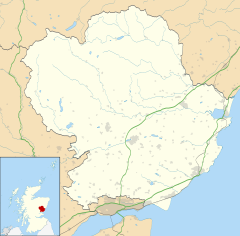Glamis
Glamis/ˈɡlɑːmz/is a small village inAngus, Scotland,located 5 miles (8 km) south ofKirriemuirand 5 miles (8 km) southwest ofForfar.It is the location ofGlamis Castle,the childhood home ofQueen Elizabeth the Queen Mother.
History[edit]

The vicinity of Glamis has prehistoric traces – within the village there stands an intricately carvedPictish stoneknown as theGlamis Manse Stone.There are various other Pictish stones nearby the village, such as theHunter's Hill Stone,and theEassie Stone,which stands inEassie Old Churchnear the village ofEassie.[1]The lastAlpínidking of Scotland,Malcolm II,died at Glamis in 1034.[2]Some other small fragments of Pictish stones from Glamis are preserved in theMeffan InstituteinForfar.
On 20 October 1491 it was declared aburgh of baronybyJames IV.[3]This gave Glamis the right to hold a weekly market, and an annual fair which was held on 17 November, the feast day ofSaint Fergus.This legacy can be seen in themercat crosswhich still stands in the village square.[4]
The humorous poetAgnes Lyonlived in the town.[5]
Glamis was the location of a flax spinning mill which in 1818 was leased by William Baxter, who later founded the major Dundee textile firm Baxter Brothers & Co Ltd.[6]
Important buildings[edit]

Glamis is a well-preservedconservation village.Much of its historic core was built to house estate workers in the late 18th century. TheAngus Folk Museum,run by theNational Trust for Scotland,is located in the village. It is a museum of days past, recreating scenes of rural life such as a minister'sparlour;a schoolroom; a laundry; and anagriculturalarea, along with displays of tools, everydayartifacts,and old crafts. It is housed in an adapted row of single storey stone cottages, originally built in 1793.
The parish church of Glamis, dedicated toSaint Fergus,was founded in the earlymedievalperiod (probably 8th century AD). The present building is 18th-century with an interior recast in the 1930s, but retains a vaulted 15th-century aisle from the medieval church which preceded it. The aisle is the burial place (photo) of theBowes-Lyon family,owners ofGlamis Castle.One of its park gates is situated near the parish church.[7]
Thecastlehosts various events throughout the year, notably thePromsevening when thousands of people traditionally turn out with picnics ranging from the small to the elaborate.
In Shakespeare[edit]
In the tragedy ofMacbethbyWilliam Shakespeare,Macbethis the Thane of Glamis. He later becomes the Thane ofCawdorand the king ofScotland,in fulfillment of the witches' prophecy.
Even though Glamis is only a small village, several cities in Britain have streets named after it. This is due to the popularity of naming streets after Shakespearean characters and locations during theVictorian Era.
See also[edit]
- Ark Hill
- Castleton
- Charleston
- Eassie Stone
- Glamis Castle
- Lord of Glamis
- Monster of Glamis
- Wester Denoon
References[edit]
- ^"C.Michael Hogan,Eassie Stone,The Megalithic Portal, ed. Andy Burnham, Oct. 7, 2007 ".Archivedfrom the original on 4 March 2016.Retrieved15 November2007.
- ^Black's Picturesque Tourist of Scotland,Adam and Charles Black, Published 1861, Scotland, 635 pages
- ^Sir James Balfour Paul,The Scots Peerage: Founded on Wood's Edition of Sir Robert Douglas' Peerage of Scotland,David Douglas, Edinburgh, 1911accessed 11 May 2018
- ^"Glamis Feature Page on Undiscovered Scotland".Archivedfrom the original on 19 November 2017.Retrieved11 May2018.
- ^J. C. Hadden, ‘Lyon, Agnes (1762–1840)’, rev. Sarah Couper, Oxford Dictionary of National Biography, Oxford University Press, 2004accessed 31 Jan 2015Archived25 November 2023 at theWayback Machine
- ^"MS 11 Baxter Brothers & Co Ltd, linen and jute spinners and manufacturers, Dundee".Archive Services Online Catalogue.University of Dundee.Archivedfrom the original on 25 November 2023.Retrieved11 August2017.
- ^Neale, John Preston (1822)."Views of the Seats of Noblemen and Gentlemen, in England, Wales, Scotland, and Ireland".Archivedfrom the original on 25 November 2023.Retrieved5 November2020.

